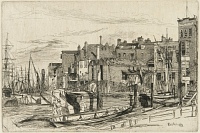Etchings Institutions search term: grolier club
Thames Police | ||
| Number: | 53 | |
| Date: | 1859 | |
| Medium: | etching and drypoint | |
| Size: | 153 x 229 mm | |
| Signed: | 'Whistler.' at lower right | |
| Inscribed: | '1859.' at lower right | |
| Set/Publication: | 'Thames Set', 1871 | |
| No. of States: | 6 | |
| Known impressions: | 81 | |
| Catalogues: | K.44; M.43; T.43; W.42 | |
| Impressions taken from this plate (81) | ||
PUBLICATION
15: The Athenaeum, 26 August 1871, p. 280. I am grateful to M. Hopkinson for this reference.
EXHIBITIONS
Across the Atlantic, it starred in several important American shows, in Cincinnati, Philadelphia, New York and Chicago. Two impressions of 'Thames Police. Wapping wharf', one a 'Trial proof; very rare' (
 ) and the other 'The same. The sky, etc, finished.' (
) and the other 'The same. The sky, etc, finished.' ( ) were lent by Samuel Putnam Avery (1822-1904) to the Union League Club, New York, in 1881. 18
Bryan Lathrop (1844-1916) lent an impression to the exhibition held by the Caxton Club in Chicago in 1900 (
) were lent by Samuel Putnam Avery (1822-1904) to the Union League Club, New York, in 1881. 18
Bryan Lathrop (1844-1916) lent an impression to the exhibition held by the Caxton Club in Chicago in 1900 ( ). 19
). 19
16: London Thomas 1861 ; see REFERENCES : EXHIBITIONS.
17: Liverpool 1874 (cat. no. 496); London Pall Mall 1874 (cat. no. 14)
18: New York 1881 (cat. nos. 61-2).
19: Chicago 1900 (cat. no. 40).
 ).
).Finally impressions were exhibited in the Memorial Exhibitions after Whistler's death, in Boston and New York in 1904, and, lent by King Edward VII, to the London Memorial show in 1905. 21
20: New York 1898 (cat. no. 39).
21: Boston 1904 (cat. no. 44); New York 1904a (cat. nos. 44a, b, c); London Mem. 1905 (cat. no. 42).
SALES & COLLECTORS
 ). 22
). 22
The next recorded sale was two years later when Whistler sold a third state to the British Museum. He actually described this as the second state, one of 'twelve proofs - etching, and dry points - selected and printed by myself - on Japanese and old dutch paper' (
 ) 23 The British Museum also bought a second state in 1868 (
) 23 The British Museum also bought a second state in 1868 ( ). Another third state of Thames Police arrived later, having been bought originally by a British collector - William Cleverly Alexander (1840-1916) - and which Whistler signed and inscribed misleadingly as 'Early proof - 1st. State -'! (
). Another third state of Thames Police arrived later, having been bought originally by a British collector - William Cleverly Alexander (1840-1916) - and which Whistler signed and inscribed misleadingly as 'Early proof - 1st. State -'! ( ).
). 22: V&A Register of Prints, p. 32.
23: Whistler to W. H. Carpenter, 3 August 1863, #11109.
24: 'Mr Whistler's Paintings', Baltimore Gazette, after 1 April 1876, in GUL PC1/75; partially quoting E.D. Wallace, 'The Fine Arts Abroad', Forney's Weekly Press, Philadelphia, 1 April 1876.
 ). A few years later, an impression was sold by Obach & Co., London, to the Kupferstichkabinett, Berlin, 1902, for £9.0.0. (
). A few years later, an impression was sold by Obach & Co., London, to the Kupferstichkabinett, Berlin, 1902, for £9.0.0. ( ). These were among the earliest public collections to acquire etchings.
). These were among the earliest public collections to acquire etchings. , similar to
, similar to  ). Freer already owned an impression on ivory laid paper, bought from Frederick Keppel & Co., New York, in 1888, but originally from a French collection (
). Freer already owned an impression on ivory laid paper, bought from Frederick Keppel & Co., New York, in 1888, but originally from a French collection ( ), and one in a set of cancelled etchings, bought from Keppel in 1896 (
), and one in a set of cancelled etchings, bought from Keppel in 1896 ( ).
). ,
,  ). These went with their collections to the New York Public Library, and the Baltimore Museum of Art.
). These went with their collections to the New York Public Library, and the Baltimore Museum of Art.
